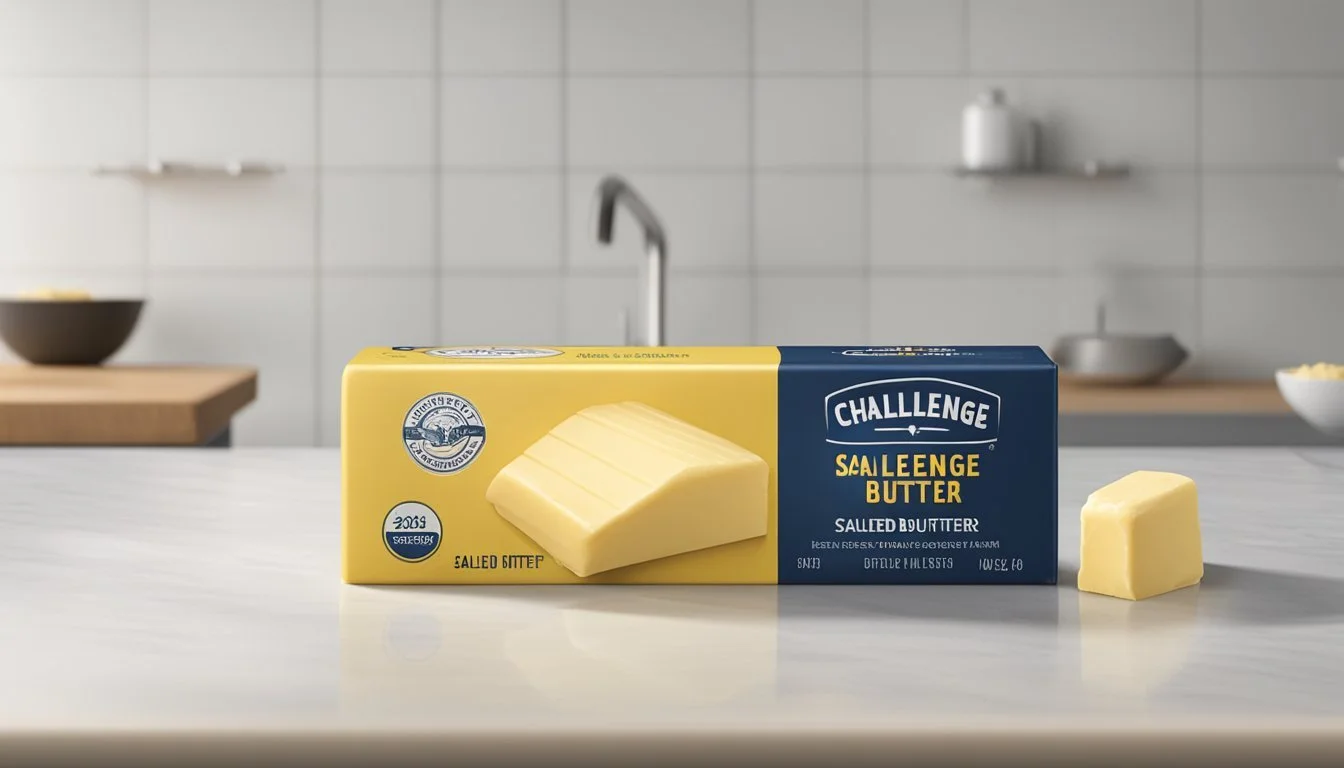How Long Does Challenge Salted Butter Last?
Shelf Life and Storage Tips
Butter (how long does butter last?), a staple in many kitchens, is a dairy product that is often questioned in terms of longevity and proper storage. Salted butter, compared to its unsalted counterpart, typically enjoys a longer shelf life due to salt's natural preservation properties. Moreover, the presence of salt enhances the flavor complexity and serves as a deterrent for bacterial growth, making salted butter a relatively shelf-stable dairy product.
The quality and taste of salted butter can be maintained when stored appropriately. At room temperature, butter remains spreadable and flavorsome, although this method is suited for shorter periods, usually a few days. Refrigeration is recommended for longer storage, substantially extending the product's life beyond its best-by or use-by date, usually for an additional two to four weeks. For even longer preservation, salted butter can be frozen, ensuring its quality for several months up to a year without significant degradation of taste.
Understanding Butter
In the world of dairy products, butter stands out for its rich flavor and culinary versatility. This section delves into the types of butter, their composition and properties, and the role of salt as a preservative.
Types of Butter
Butter can be broadly categorized into salted butter and unsalted butter. Salted butter, as the name implies, contains salt, which not only enhances flavor but also acts as a preservative. Unsalted butter, sometimes called "sweet cream butter," does not have any added salt, giving it a purer taste of cream but a shorter shelf life.
Composition and Properties
Butter is essentially made from the fat of milk, typically cow's milk. It contains a high fat content, usually around 80%, with the remaining percentage constituting water and milk solids. This high concentration of fat is what gives butter its creamy texture and ability to enhance the flavors in various dishes.
Salt as a Preservative
Salt is a natural preservative and plays a crucial role in extending the shelf life of culinary products. In salted butter, it helps maintain freshness by lowering water activity, which inhibits the growth of bacteria. Consequently, salted butter has a longer shelf life compared to unsalted butter, which lacks this defense against spoilage.
Storing Butter
Proper storage of Challenge Salted Butter maintains its quality and extends its shelf life. The butter can be refrigerated, frozen, or kept at room temperature based on specific preferences and needs.
Refrigerating Butter
Refrigerated butter retains its quality for a prolonged period. Challenge Salted Butter should be stored in a covered container in the refrigerator to prevent absorbing odors from other foods. Typically, refrigerated butter stays fresh for about one to two months. It is recommended to use the original packaging to keep the butter airtight and to maintain its flavor and freshness.
Freezing Butter
Butter can be frozen to extend its shelf life even further. When properly wrapped to prevent freezer burn and odor contamination, frozen butter can last for up to six months. One should wrap the butter in aluminum foil or plastic wrap and place it in a freezer bag. It is crucial to thaw the butter in the refrigerator for a day before use to ensure even consistency when it returns to a spreadable state.
Room Temperature Storage
Storing butter at room temperature offers immediate spreadability, but it requires careful consideration. Room temperature storage is safe for a short time, generally up to one week. The butter should be in a butter dish with a lid to protect it from contaminants and to manage exposure to air. The storage environment should also be cool, away from direct sunlight and heat sources to prevent the butter from spoiling.
Shelf Life Information
When assessing the longevity of Challenge salted butter, it is important to understand that the shelf life can vary. Consumers should be mindful of the labeling and signs of spoilage to ensure the butter remains suitable for consumption.
Determining Expiration Date
On the packaging of Challenge salted butter, the consumer will find a "best by" date which serves as a manufacturer's estimate for peak quality. The use-by or sell-by dates may also be present, offering additional guidance. It is advisable to consume the butter by these dates to experience the best flavor and quality.
"Best by" date: Indicates when butter is expected to start declining in quality.
Sell-by/use-by date: Often indicates the last day the store should sell the product, but it can still be safe and flavorful for consumption after this date.
Signs of Spoilage
Salted
Usage Tips
When cooking or baking with Challenge salted butter, proper preparation and technique ensure optimal flavor and texture in dishes. Understanding how to handle butter for various culinary applications can make a significant difference in the end result.
Preparation for Use
One should allow Challenge salted butter to soften at room temperature before using it as a spread or for creaming in baking recipes. To quickly soften butter, it can be cut into small cubes or grated. For controlled softening, a microwave may be used with caution, employing short bursts of power to avoid melting.
For spreads: Soften just until spreadable, maintaining structure.
For baking: Soften until it can be creamed with sugar.
Cooking and Baking
Cooking and baking often require specific amounts of butter; Challenge butter can be cut as per recipe needs. In cooking, they might use it for sautéing to add rich flavor. When Challenge butter is incorporated into baked goods, it imparts tenderness and can create flaky layers in pastries.
For sautéing: Start with a moderate heat to prevent burning.
For baking: Measure carefully for consistency and expected results.
Whether spreading on toast or folding into a batter, Challenge salted butter elevates the taste and texture of culinary creations when used mindfully and prepared appropriately.
Health and Safety
When it comes to Challenge Salted Butter, understanding the health and safety aspects is crucial. This includes the risks associated with spoiled butter and adherence to dairy product guidelines.
Risks of Spoiled Butter
Spoiled butter can pose health risks, primarily due to rancidity and bacterial growth. When butter turns rancid, it is a result of the fats within it breaking down; this process can lead to an unpleasant smell and taste. More importantly, consuming rancid butter can cause digestive discomfort. Spoiled butter may also harbor harmful bacteria, which can lead to foodborne illnesses. Consumers can usually identify spoilage by a noticeable change in color, texture, or an off odor.
Dairy Product Guidelines
Dairy products, including butter, have specific guidelines to ensure food safety. Challenge Salted Butter should be stored properly to prevent spoilage. According to food safety practices, it should be kept refrigerated at or below 40°F. Salted butter has a longer shelf life than unsalted varieties due to salt's preservative effects. However, if the butter develops an off smell, a discolored appearance, or any signs of mold, it is no longer safe to use. Always use a clean utensil to avoid contamination when handling butter, and adhere to the "use-by" date provided on the packaging as a general guideline for freshness.
Comparative Insights
When considering the longevity of Challenge Salted Butter, one must compare it to its alternatives as well as the unsalted variant to understand its shelf life in context.
Butter vs. Alternatives
Margarine: While butter is a dairy product, margarine is primarily made from vegetable oils, which allows for a longer shelf life. Margarine can last up to 4-5 months past its sell-by date when refrigerated, outlasting salted butter which typically remains fresh for 1-3 months in the refrigerator after its sell-by date.
Ghee: Ghee, a type of clarified butter with a higher fat content, can last up to a year at room temperature without spoiling due to moisture content being removed.
Yogurt and Shortening: Yogurt, although a dairy product like butter, has a completely different composition and shelf life and thus is not a direct substitute. On the other hand, shortening, utilized for similar baking applications as butter, has a long shelf life that can extend up to two years due to its near-complete fat makeup.
Salted vs. Unsalted Butter
Salted Butter: Salt acts as a natural preservative, enabling salted butter like Challenge Butter to last longer compared to its unsalted counterpart. Given the same storage conditions, salted butter has about a 30-day longer shelf life.
Storage: Refrigerator shelf life:
Salted butter: 1-3 months after sell-by date
Unsalted butter: 3 weeks to 2 months after sell-by date
Freezer: Freezing extends shelf life exponentially:
Salted and unsalted butter: up to a year, avoiding taste and quality degradation
High Fat Content: Butters with a higher fat content, including those labeled as premium or European-style, may stay fresher longer due to fat acting as a preservative in addition to salt. Challenge Salted Butter, churned daily, prides itself on a simple and pure high-fat composition, which may contribute to its favorable shelf life.
Maintaining Quality
Maintaining the quality of Challenge salted butter hinges on effective handling and storage practices that prevent spoilage, ensuring that texture and flavor remain at their peak.
Proper Butter Handling
To ensure butter retains its quality, it should be handled properly. Using a clean knife for cutting and keeping butter covered when not in use are vital steps to prevent contamination. Butter should be shielded from light and heat, as both can accelerate the oxidation process, leading to off-flavors and rancidity. This is predominantly important for salted butter, as while the salt content does act as a safeguard, safeguarding against oxidation ensures the preservation of both the quality and the texture.
Extending Shelf Life
Freezing is an excellent method to extend the shelf life of Challenge salted butter, with the potential to keep quality for six months to a year. Butter should be well-wrapped to prevent freezer burn and to protect from absorbing odors, as this affects its delicate flavor profile. The water content in butter can lead to texture changes when frozen, but this is less of an issue with salted butter than unsalted varieties. Temperature control is crucial, as fluctuating temperatures can lead to spoilage. Preventing oxygen exposure is key in mitigating the oxidation process, aiding in maintaining fresher butter for longer.








